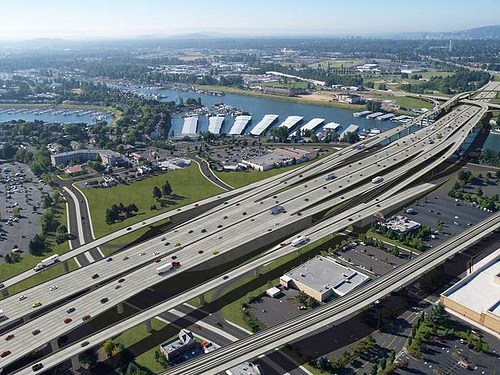The plan to spend $5 billion widening the I-5 Bridge Over the Columbia River would produce 100,000 additional metric tons of greenhouse gases per year, according to the induced travel calculator
Metro’s 2020 transportation package would have cut greenhouse gases by 5,200 tons per year– 20 times less than the additional greenhouse gases created by freeway widening.
Widening freeways induces additional travel. It’s an established scientific fact: widening urban freeways prompts more miles of travel and consequently, more greenhouse gas emissions. The effect is so well-documented that its referred to as the “fundamental law of road congestion.”
Based on a synthesis of the latest award-winning peer-reviewed scientific research and work by scholars at the University of California, Davis‘s National Transportation Center, the Natural Resources Defense Council developed the induced travel calculator that computes the additional amount of greenhouse gases produced by an additional lane-mile of freeway capacity in each of the nation’s metro areas.
The proposed Columbia River Crossing, now re-branded as the “I-5 bridge replacement project”, contemplates a 12-lane wide, 5 mile long freeway between Portland and Vancouver, effectively doubling the size of the existing I-5 freeway and adding 30 lane miles of freeway (3 lanes in each of 2 directions for 5 miles). Freeway advocates have claimed that the bridge might only be 10 lanes, but as public records requests revealed, the bridge structure is designed to carry twelve lanes, and in many places the proposed roadway is 14 lanes wide.
The Induced Travel Calculator shows that this increase in roadway capacity in Portland would produce an addition 155 to 233 million miles of travel annually, leading to burning an additional 11 million gallons of gas. That in turn would translate into additional annual greenhouse gases of about 100,000 tons (at roughly 20 pounds of CO2e per gallon of gas).
How big is that amount? Well, to put in perspective, let’s compare it to the expected greenhouse gas reductions from other possible transportation investments. In 2020, Metro advances a multi-billion dollar transportation spending project including light rail, bus lanes, pedestrian and safety improvements and other projects. Metro estimated that this package of investments would reduce greenhouse gases by about 5,200 metric tons per year.
State, regional and local government officials all recognize that we’re in the midst of a climate crisis. It should be apparent to any casual observer that widening freeways takes us in the opposite direction of our stated commitments to reduce greenhouse gases. In fact, the best scientific estimates of the emissions from added freeway capacity suggests that widening I-5 would generate 20 times more greenhouse gas emissions than would have been saved by the multi-billion dollar package of projects proposed by Metro last year. Given the cost and difficulty of reducing greenhouse gas emissions, the last thing we should be doing is making the problem worse.




